 | |
| History | |
|---|---|
| Name: | Seminole |
| Builder: | Maxon & Fish, Mystic, CT |
| Launched: | 1865 [1] |
| General characteristics | |
Seminole was a later clipper ship, built by Maxon & Fish at Mystic, Connecticut, in 1865. [1]
 | |
| History | |
|---|---|
| Name: | Seminole |
| Builder: | Maxon & Fish, Mystic, CT |
| Launched: | 1865 [1] |
| General characteristics | |
Seminole was a later clipper ship, built by Maxon & Fish at Mystic, Connecticut, in 1865. [1]
She was one of only two clipper ships in the post-Civil War period (1865–1900) to make a passage from an Atlantic port to San Francisco in less than one hundred days. Seminole arrived at San Francisco from New York on March 10, 1866, in 96 days. Glory of the Seas, “the last ship built by Donald McKay, made the same voyage, arriving at San Francisco, January 18, 1874, in 94 days." [1]
Seminole left New York on December 3, 1865, and arrived in San Francisco on March 11, 1866 of that after a voyage of 97 days, carrying Central Pacific locomotive CP 10. [2]

Flying Cloud was a clipper ship that set the world's sailing record for the fastest passage between New York and San Francisco, 89 days 8 hours. The ship held this record for over 130 years, from 1854 to 1989.

The Pacific Mail Steamship Company was founded April 18, 1848, as a joint stock company under the laws of the State of New York by a group of New York City merchants. Incorporators included William H. Aspinwall, Edwin Bartlett, Henry Chauncey, Mr. Alsop, G.G. Howland and S.S. Howland.
USS Ino was a clipper ship acquired by the Union Navy during the course of the American Civil War. She was capable of great speed and distance, and was a formidable warship with powerful guns.

Northern Light was an American clipper ship. In 1853 she sailed from San Francisco, California to Boston, Massachusetts via Cape Horn with Captain Freeman Hatch at the helm in a record-setting 76 days, 6 hours. The record still stands for a single hull vessel. In 1993 the record was soundly broken by a multi-hull sailing vessel Great American II with no cargo. Sailing around Cape Horn is widely regarded as one of the most challenging routes in yachting, due to extreme weather, strong currents, and a historical reputation for mountainous seas and frequent severe storms.

Cremorne was a clipper ship of Sutton and Co.'s Dispatch Line and Coleman's California Line. She sailed between New York and San Francisco. Her services were advertised in sailing cards.

Surprise was a California clipper built in East Boston in 1850. It initially rounded Cape Horn to California, but the vessel's owners, A. A. Low & Brother, soon found that the vessel performed well in Far Eastern waters. From that point onward the vessel spent much of her working life in the China trade, although the vessel also made three trips from the East Coast of the United States to California.

The Young America was built by William H. Webb of New York. She was launched in 1853, at the height of the clipper construction boom. She sailed in the California trade, on transatlantic routes, and made voyages to Australia and the Far East.
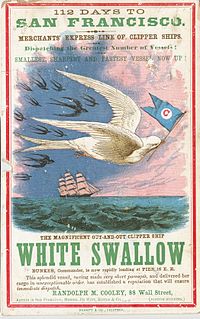
White Swallow was an extreme clipper built in Boston in 1853 for the California trade.
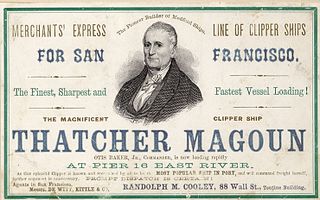
The Thatcher Magoun, an extreme clipper launched in 1855, was named after Medford's great shipbuilder, Thatcher Magoun, who died the year that she was launched.
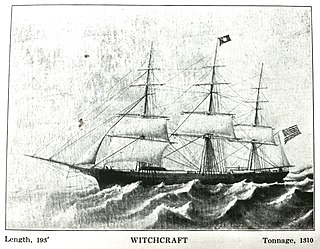
Witchcraft was a clipper built in 1850 for the California and China trade. She made record passages from Rio de Janeiro to San Francisco, and from San Francisco to Callao, Peru.

Carrier Dove was an 1855 medium clipper. She was one of two well-known clippers launched in Baltimore that year, the other being Mary Whitridge.
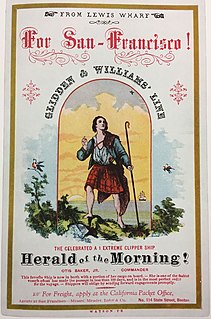
Herald of the Morning was one of the few clipper ships with a passage to San Francisco in less than 100 days.
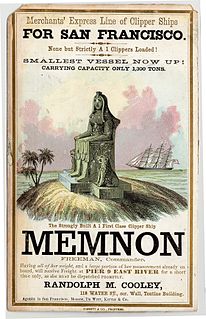
The Memnon was the first clipper ship to arrive in San Francisco after the Gold Rush, and the only clipper to arrive in San Francisco before 1850. Built in 1848, she made record passages to San Francisco and to China, and sailed in the first clipper race around Cape Horn.
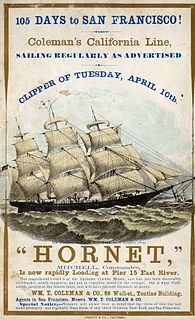
Hornet was an 1851 extreme clipper in the San Francisco trade, famous for its race with Flying Cloud.
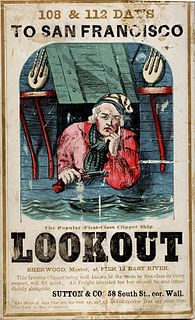
Lookout was an 1853 clipper known for her passages from New York to San Francisco, and as an offshore and coastal trader in the lumber and coal trades.

Golden Fleece was an 1855 medium clipper in the California trade, built by Paul Curtis. She was known for arriving with cargoes in good condition, for making passages in consistently good time, and for catching fire with a load of ice.

Comet was an 1851 California clipper built by William H. Webb which sailed in the Australia trade and the tea trade. This extreme clipper was very fast. She had record passages on two different routes: New York City to San Francisco, and Liverpool to Hong Kong, and beat the famous clipper Flying Dutchman in an 1853 race around the Horn to San Francisco.
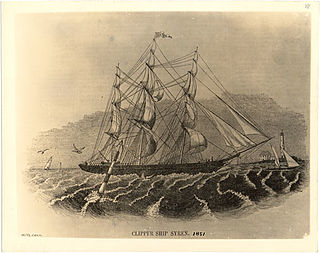
Syren was the longest lived of all the clipper ships, with a sailing life of 68 years 7 months. She sailed in the San Francisco trade, in the Far East, and transported whaling products from Hawaii and the Arctic to New Bedford.

The Golden State was an extreme clipper ship built by Jacob Aaron Westervelt in 1852 in New York City and launched on January 10, 1853. For her last few years of service, she was renamed the Anne C. Maguire.

Glory of the Seas was a clipper ship launched in 1869. She was the last merchant sailing vessel built by Donald McKay.